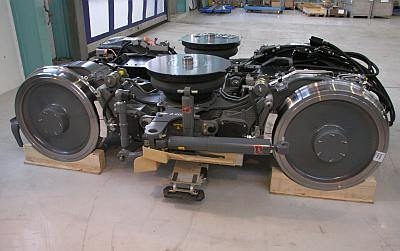The new SF7000 bogie is designed to reduce track wear on a 1000m-radius curve by up to 75%, compared with the SF5000. By reducing track wear and train weight lower variable track access charges will be payable by operators using the bogies.
The need to reduce weight and to reduce whole life-cycle costs has prompted a number of major bogie design changes. These include the use of an inboard bearing design rather than traditional external bogie frame with a shorter axle spacing. In addition, smaller diameter wheels and hollow axles are used. Other components have been redesigned to use less weight. For example, the weight of the yaw damper mounting bracket has been reduced from 22.7kg to 17.9kg but doubled in stiffness by using tempered steel castings.
Elsewhere Siemens has used alternative, more costly material, to reduce weight. The third rail shoe gear uses aluminium instead of steel, making it 25% lighter than the design used on the first-generation Desiro UK (class 450).
Tread brakes are used alongside regenerative electric brakes on SF7000 motor bogies to reduce weight within the space constraints imposed by the restrictive British loading gauge, which makes disc brakes harder to accommodate.
In total 2280 SF7000 bogies will be required for the Thameslink order - split equally between powered and unpowered. Once the order is finalised, Siemens will produce the bogies using the "synchronised assembly" method at its plant in Graz, Austria, with a completed bogie rolling off the production line every four hours between March 2013 until 2016.
Production of the SF7000 will represent 22-26% of the Graz plant's workload and around a fifth of the initial assembly production space will be dedicated to the order.

